3.5 QAM Demodulation Using Complex-Valued Signals
This section discusses QAM demodulation, i. e., the process of recovering the symbols embedded in the received waveform. The process can be organized into two tasks: 1) recovering the complex-valued symbols, i. e., an eventually noisy version of the complex envelope, and then 2) making decisions by finding the nearest-neighbor constellation point to each received QAM symbol. The second task is briefly discussed in the next paragraphs, assuming square QAM constellations.
3.5.1 PAM-based detector scheme for square QAM
Note that some “demodulation” functions in Matlab/Octave simply perform the decision or detection process. Here, sticking with this nomenclature, a function called ak_qamdemod.m is described.
The implementation of the decision stage is simplified if a square QAM (SQ QAM) constellation is adopted, where the number of bits in an even integer. As suggested by Figure 2.24, the SQ QAM constellation is the Cartesian product of two identical PAM constellations with symbols each. Listing 3.4 illustrates the demodulation for this specific constellation. The case where is an odd number is not considered at this moment.
1function [symbolIndex, x_hat]=ak_qamdemod(x,M) 2% function [symbolIndex, x_hat]=ak_qamdemod(x,M) 3%It is restricted to "square" QAM constellations. It does 4%not support "cross" constellations. 5%Inputs: x has the QAM values and M the number of symbols 6%Outputs: symbolIndex has the indices from 0 to M-1 7% x_hat contains the nearest symbol(s) 8b=log2(M); %number of bits 9b_i = ceil(b/2); %number of bits for in-phase component 10b_q = b-b_i; %remaining bits are for quadrature component 11M_i = 2^b_i; %number of symbols for in-phase component 12M_q = 2^b_q; %number of symbols for quadrature component 13ndx_i=ak_pamdemod(real(x),M_i); %PAM on in-phase 14ndx_q=ak_pamdemod(imag(x),M_q); %PAM on quadrature 15symbolIndex = ndx_i*M_q + ndx_q; %get QAM index 16if nargout > 1 %calculate only if necessary 17 const=ak_qamSquareConstellation(M); %QAM const. 18 x_hat=const(symbolIndex+1);%add 1 to indices 19end
The decision process is just one among other used for demodulation. The next paragraphs discuss distinct ways for estimating the complex envelope, which is a process that precedes the decision in many demodulation schemes.
3.5.2 QAM demodulation of complex-valued signals with lowpass filter
As in the QAM generation stage, using complex-valued signals can help mathematically describing and implementing QAM demodulation.
When complex-valued signals are used, Figure 3.7 depicts an alternative for QAM demodulation. This demodulation used a lowpass filter and another alternative that will be discussed is to use a phase splitter, which incorporates a Hilbert filter.
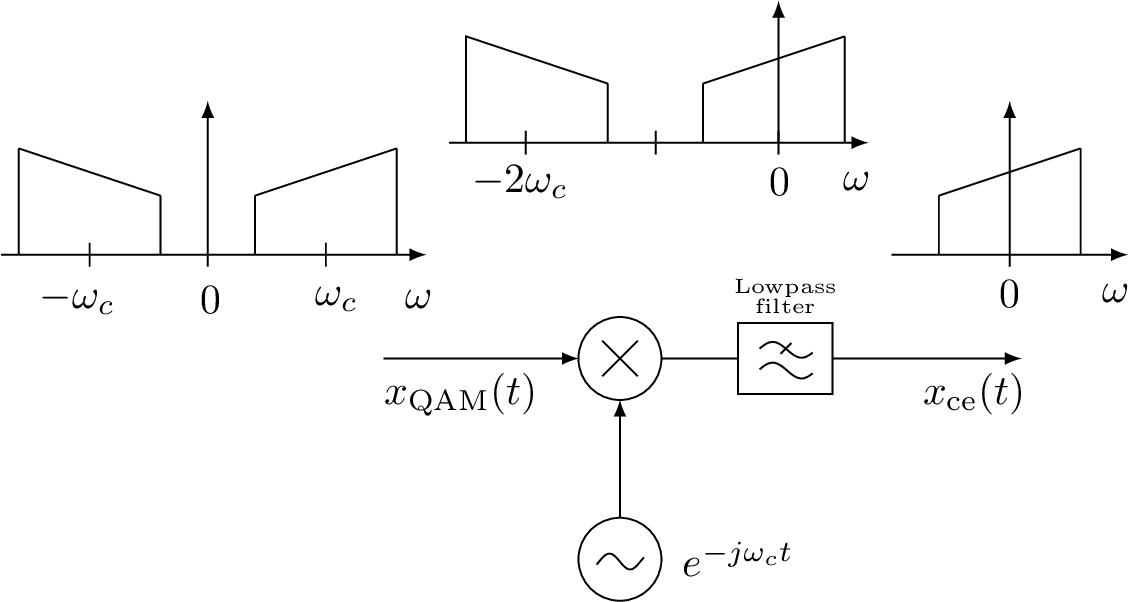
Hence, as an example of an alternative to accomplish QAM demodulation, Listing 3.5 illustrates how to recover the QAM symbols and leads to the same results as Listing 3.2. Note that the first lines of Listing 3.5 are not listed but coincide with Listing 3.3, which is used to obtain the transmitted QAM signal z.
17r = z; %ideal channel: no noise (z already defined). Run QAM demod.: 18n=0:length(r)-1; %integer indices that represent time evolution 19wc=pi/2; %carrier frequency in radians 20carrier=2*exp(-1j*wc*n); %generate complex carrier. Note factor = 2 21rbb=r.*carrier; %shift one QAM replica to the baseband 22b=fir1(length(p)-1,0.5); %FIR with same order of the shaping filter 23ybb=conv(b,rbb); %filter out replica at twice the carrier frequency 24ybb(1:floor(length(p)/2)+floor(length(b)/2))=[];%discard group delays 25ys=ybb(1:L:L*S); %sample S symbols, at baud rate 26symbolIndicesRx=ak_qamdemod(ys,M); %QAM demodulation 27SER=ak_calculateSymbolErrorRate(symbolIndicesRx,ind)
Listing 3.6 provides code to show the original constellation and the received symbols.
1%Plot constellation (ys has been previously defined): 2plot(real(ys),imag(ys),'x','markersize',20); %received 3hold on, plot(real(qamSymbols),imag(qamSymbols),'or'); %transmitted 4axis equal; axis([-4 4 -4 4]); %force axis to have same lengths 5title('Transmitted (o) and received (x) constellations'); 6xlabel('Real part of QAM symbol m_i'); 7ylabel('Imaginary part of QAM symbol m_q');
Figure 3.7 assumed continuous-time signals, but discrete-time processing can be used as well. For example, a single (and relatively fast) ADC can be used to digitize the passband QAM signal and the frequency downconversion and filtering performed in the digital domain.
3.5.3 Advanced: QAM demodulation of complex-valued signals via phase splitter
Now, the option of using a phase splitter via a Hilbert transform in QAM demodulation is discussed. Complementing the example provided by Figure 3.6, Figure 3.8 illustrates two stages in QAM demodulation: obtaining the analytic signal and downconversion. This first stage will be described in the sequel.
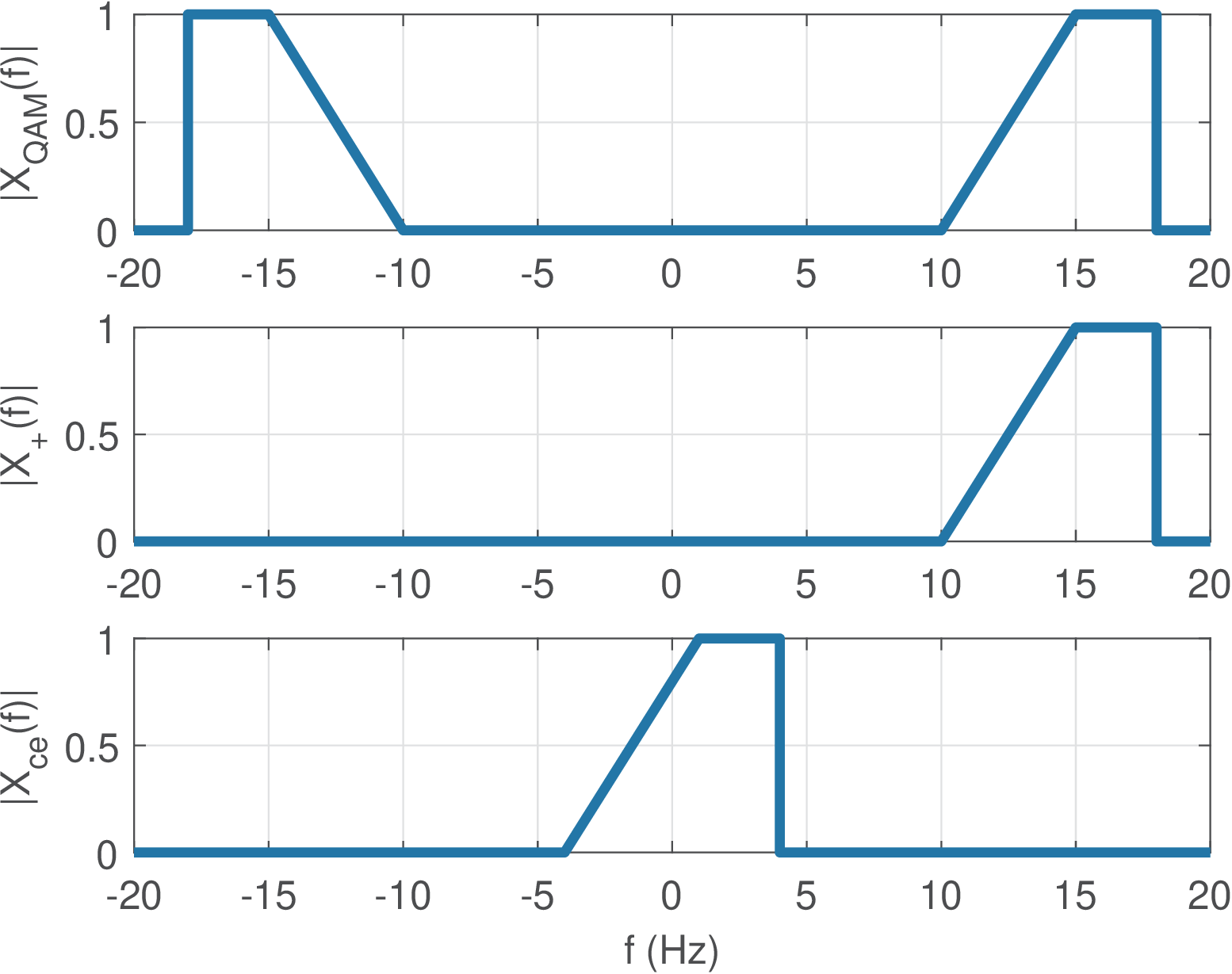
Using a unit step function in frequency domain ( is the sign function) allows to obtain
which eliminates the negative frequencies of the passband spectrum . The goal is to obtain an analytic signal to represent the passband signal . An analytic signal has a spectrum that is zero for . The inverse Fourier transform of is
where the factor will be compensated by multiplying by 2 (note in Figure 3.8 the multiplication by 2 when generating the analytic signal, which also shows up in Figure 3.6). Therefore, for convenience, the analytical signal is defined in frequency domain as
|
| (3.8) |
Interpreting the analytical signal in time domain leads to
At this point, it is helpful to note that
is the impulse response of a Hilbert filter and the Hilbert transform of a signal is
Hence, one can obtain the analytic signal by means of a Hilbert transform as follows:
where in this case is the Hilbert transform of . Note that the real part of is the input signal itself and the imaginary part is . A system that obtains the analytic signal from a real input signal is called phase splitter. Figure 3.9 illustrates a phase splitter operating in continuous-time signals. It can also be used in discrete-time, for example, on a digitized passband QAM signal such that only one high-frequency ADC is used, instead of a dual ADC to digitize the I/Q components.
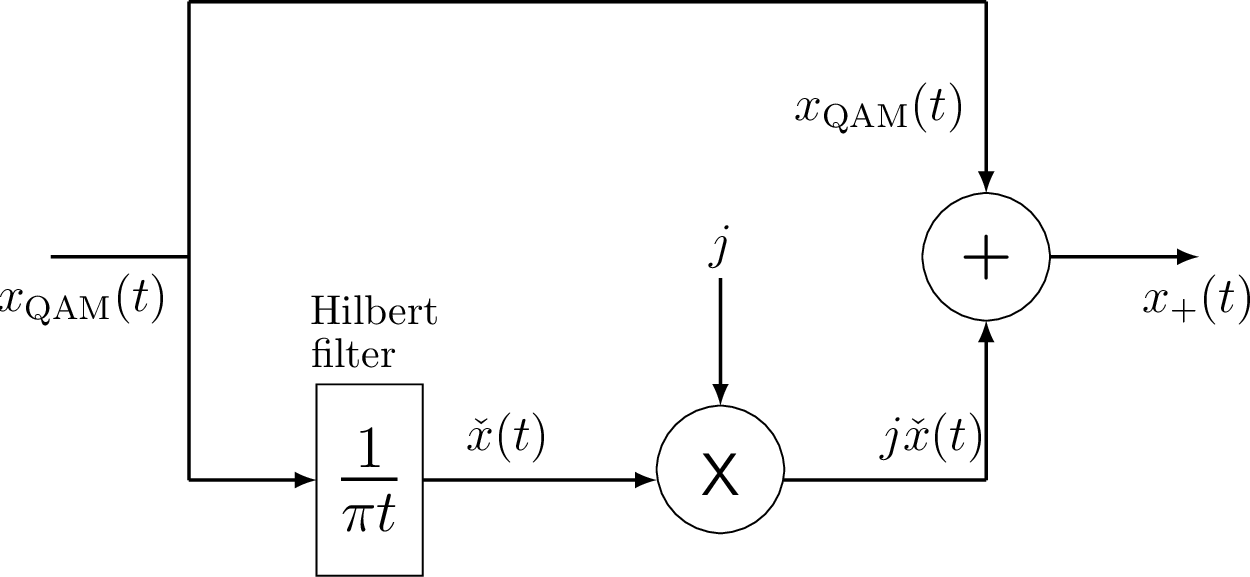
After the phase splitter of Figure 3.9, the QAM complex envelope can be obtained by frequency downconverting the resulting analytic signal, as depicted in Figure 3.10.
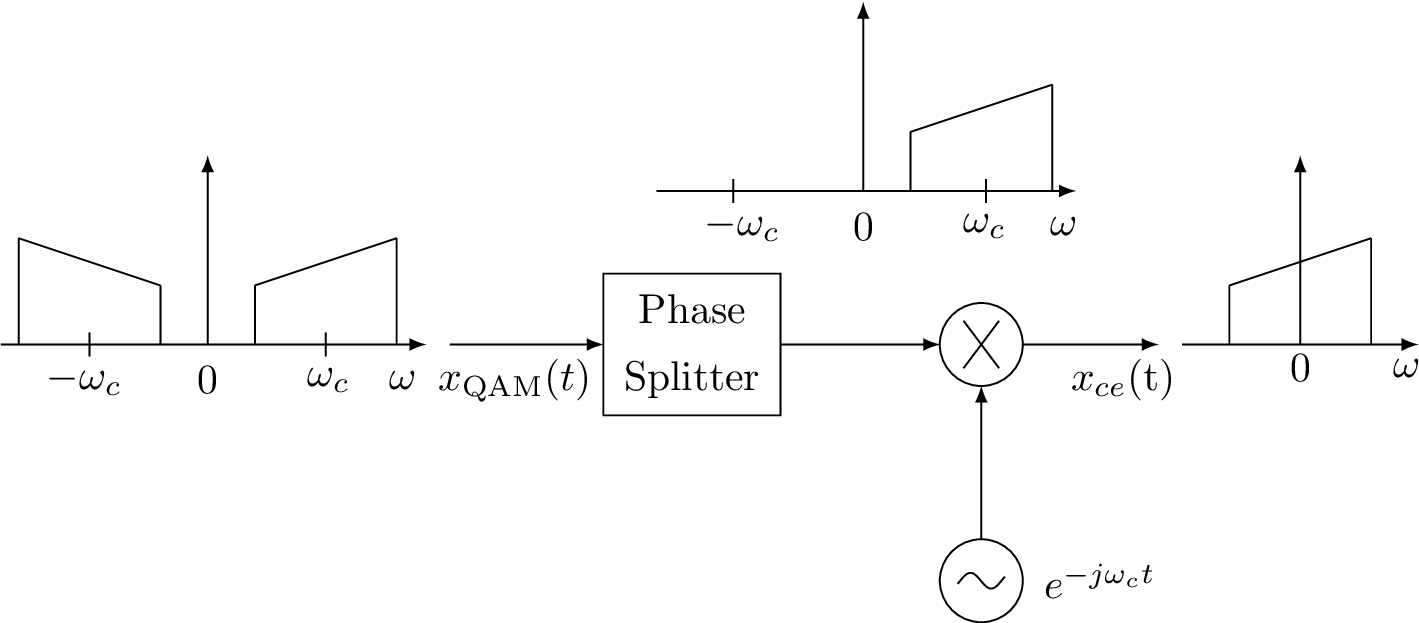
While the Fourier transform of the phase splitter is , the transform of the Hilbert filter denoted by its impulse response is . The top and bottom branches that compose the phase splitter of Figure 3.9 have Fourier transforms equal to 1 (top branch) and , such that their sum leads to .
Observing the role played by the Hilbert transform, and it does not alter the magnitude of the input unless , which does not occur for passband signals. Hence, the Hilbert transform changes the signal phase by adding rad to components at positive frequencies and to components at negative frequencies.
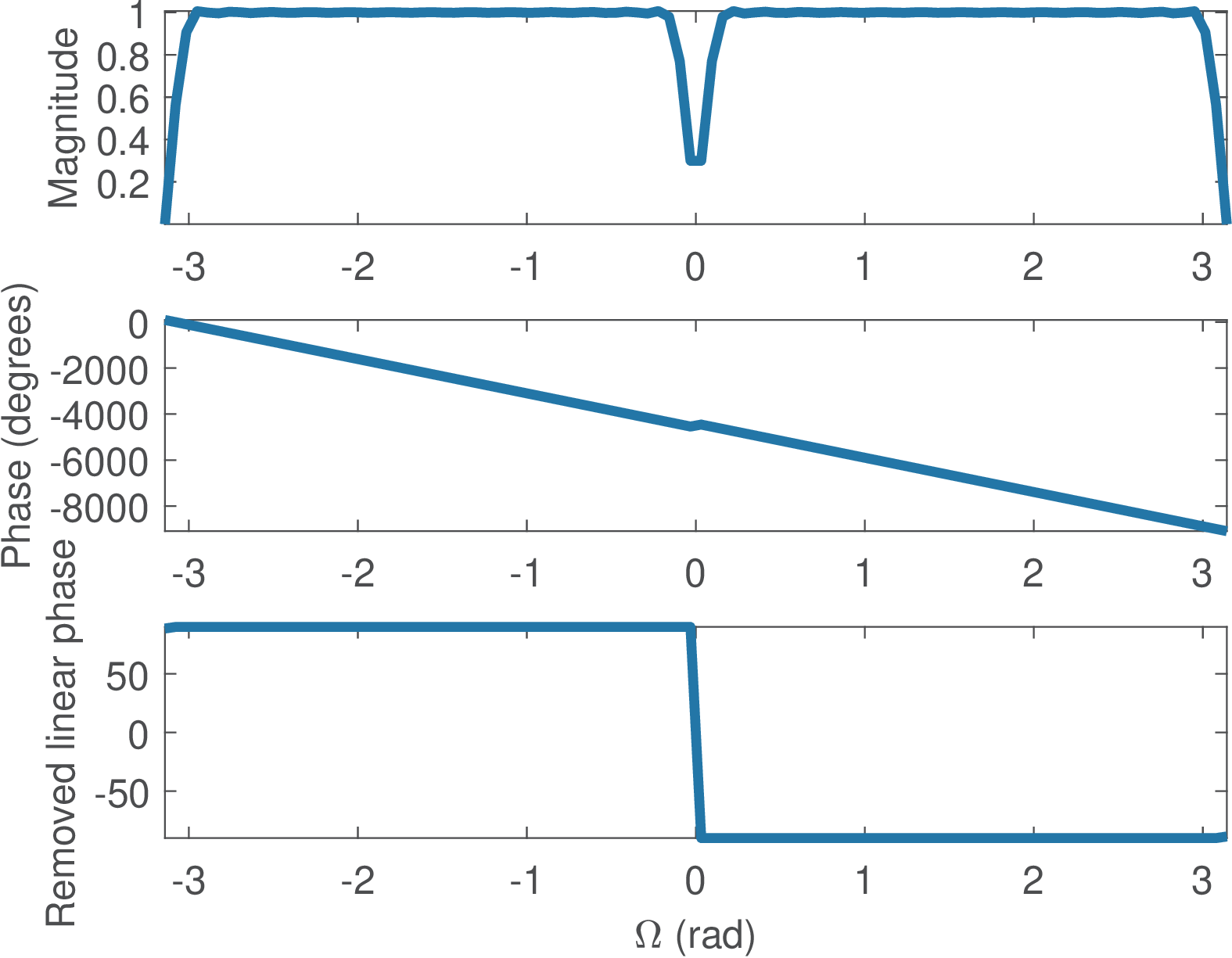
Figure 3.11 depicts the frequency response of a Hilbert filter2 obtained with Listing 3.7.
1N = 52; % Filter order 2F = [0.05 0.95]; % Frequency Vector 3A = [1 1]; % Amplitude Vector 4W = 1; % Weight Vector 5b = firls(N, F, A, W, 'hilbert'); %design Hilbert filter
Note that any causal FIR filter will have a linear phase that can hide the effect of a Hilbert transformer on the input signal’s phase (the shift). The bottom plot in Figure 3.11 was obtained with Listing 3.8, where N/2=26 in this case.
1w=linspace(-pi,pi,100); %frequency in rad 2H=freqz(b,1,w); %calculate frequency response (b has been defined) 3H2=H.*exp(j*(N/2)*w); %compensate linear phase 4plot(w,angle(H2)/pi*180); %convert to degrees
When using filters, the transients need to be taken into account. Listing 3.9 illustrates the use of a causal Hilbert filter to recover the complex envelope.
17r = z; %ideal channel, no noise, unlimited band (z was defined) 18%run the demodulation using complex signals 19%First design a Hilbert filter (or transformer) 20N = length(p)-1; % Order 21F = [0.05 0.95]; % Frequency Vector 22A = [1 1]; % Amplitude Vector 23W = 1; % Weight Vector 24b = firls(N, F, A, W, 'hilbert'); 25yhilbert = conv(b,r); %Hilbert transform 26yhilbert(1:floor(length(b)/2))=[]; %take out transient 27ya = r + j*yhilbert(1:length(r)); %analytic signal 28ybb = ya .* exp(-j*pi/2*n); %downconversion 29ybb(1:floor(length(p)/2))=[]; %take out transient 30firstSample = 1; %first sample to start getting symbols 31ys=ybb(firstSample:L:L*S); %sample S symbols, baud rate 32symbolIndicesRx=ak_qamdemod(ys,M); %QAM demodulation 33SER=ak_calculateSymbolErrorRate(symbolIndicesRx,ind)
An alternative to using a causal filter is the hilbert function, which outputs the analytic signal and instead of a FIR filter uses FFT. Listing 3.10 illustrates the use of hilbert.
17r = z; %ideal channel: no noise, unlimited band (z was defined) 18%run the demodulation using complex signals 19ya = hilbert(r); %get analytic signal 20ybb = ya .* exp(-j*pi/2*n); %downconversion 21ybb(1:floor(length(p)/2))=[]; %take out transient 22firstSample = 1; %first sample to start getting symbols 23ys=ybb(firstSample:L:L*S); %sample S symbols, baud rate 24symbolIndicesRx=ak_qamdemod(ys,M); %QAM demodulation 25SER=ak_calculateSymbolErrorRate(symbolIndicesRx,ind)
It should be noted that the hilbert function used in Listing 3.10 does not implement the Hilbert transform, but the complete phase splitter.
The following simple example aims at providing insight on recovering a signal after its components corresponding to negative frequencies were eliminated.
Example 3.1. Recovering a real-valued signal using only the values of its Fourier transform corresponding to positive frequencies. As an exercise and assuming discrete time, Listing 3.11 illustrates how to recover an arbitrary signal (representing ) from the values corresponding to positive frequencies of its FFT.
1x=[1 2 3 4 5 6] %define an arbitrary test vector 2X=fft(x); N=length(x); %calculate FFT and its length 3Xu=[X(1) 2*X(2:(N/2)) X((N/2)+1)]; %Xu = 2 u(f) X(f) 4x2 = real(ifft(Xu,N)) %use ifft zero-padding. find x2=x
Note in Listing 3.11 that the DC and Nyquist frequencies are not scaled by 2.